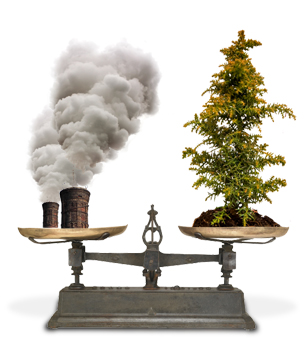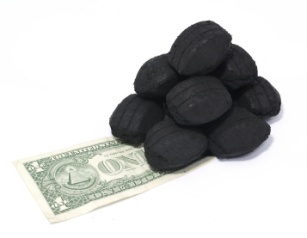America’s first major stab at tackling global climate change comes in the form of the American Clean Energy Security Act, a massive piece of legislation that would touch nearly every corner of the U.S. economy.
The bill, often referred to as “Waxman-Markey” after its principal sponsors in the House of Representatives, contains provisions for clean energy technology, energy efficiency, green building codes, green jobs, and adaptation measures to help ease people into a new world order. But its most talked about feature is the regulation arm, “cap and trade”: limit pollution to a finite amount, lower the allowable amount each year, and let polluters trade pollution permits to create market incentives for businesses to reduce emissions as cheaply as possible.
Modeled, in part, on the federal program created in the early 1990s to combat acid rain, the Waxman-Markey trading scheme would create a mandatory (or compliance) market in greenhouse gas emission credits for businesses regulated under the cap. Credits would be measured in carbon dioxide equivalent (CO2e), where each type of greenhouse gas is converted to its equivalent in CO2, the most common greenhouse gas. Hence the term “carbon markets.”
But here’s the rub: Waxman-Markey does not propose a pure cap-and-trade scheme. It’s actually cap and trade and offset. Offsets, put simply, would let polluters pump more carbon dioxide into the atmosphere than they would be permitted under the “cap” part of the program. Companies would earn that right by investing in projects in the United States or in other countries that reduce the amount of carbon dioxide being emitted into the atmosphere.
Supporters, including regulated industries, agribusiness, and some environmentalists, say offsets would control the cost of pollution permits, helping the country transition to a low-carbon economy without jolting price increases for energy. One factor that influenced the inclusion of offsets in Waxman-Markey was a June 23 EPA analysis (PDF), which found that without international offsets, the cost of permits, also called allowances, would be 89 percent higher.
Still, critics charge that offsets as envisioned by Waxman-Markey would defeat the overriding goal of cutting emissions. That’s because ensuring the quality of offsets — i.e. that greenhouse gas reductions are actually happening — has proven to be a tall order.
Offsets are hardly a new phenomenon. A robust voluntary market emerged internationally and in the United States during the past decade as businesses raced to flaunt their sustainable bona fides. Several major rental car companies give drivers the option of buying offsets. Online retailer Destination Lighting touts its purchase of offsets as a selling point. Pacific Gas and Electric, a huge utility in California, announced in July that it is offsetting some of its carbon emissions by supporting The Conservation Fund’s forestry projects; money for the offsets comes from customers who opt to pay extra each month. Dell, the personal computer manufacturer, is a large purchaser of offsets, as is search-engine giant Google.
Inevitably, the offsets trend prompted a backlash: questions about methodology and merit, comparisons to sin indulgences, nicknames like “rip-offsets” (thanks, Joe Romm!), and parodies like Cheat Neutral. In August 2008 the Government Accountability Office lent a stamp of authenticity to these concerns by issuing a report that outlined the challenges associated with the voluntary market for offsets. And on August 3, the Congressional Budget Office issued a report (PDF) that, while concluding offsets under the Waxman-Markey bill would likely reduce compliance costs and cut carbon emissions, conceded that a lot depends on the design of the program and how offsets are certified.
If regulated companies are allowed to buy offsets as an alternative to reducing their own emissions or buying extra allowances under the cap, and if those offsets aren’t actually reducing pollution, then we would be merely running a “shell game,” not tackling climate change, said Daphne Wysham, a fellow at the Institute for Policy Studies, an independent think tank based in Washington, D.C.
In spite of these concerns, lobbyists for offsets struck it big with Waxman-Markey: The bill, which was narrowly passed by the House on June 26, would authorize up to 2 billion tons annually until 2050. In 2007, 2 billion tons would have been about 29 percent of total U.S. greenhouse gas emissions, according to the EPA’s 2009 U.S. Greenhouse Gas Inventory Report. This is a massive increase over the 10.2 million tons traded in the United States in 2007, according to the August 2008 GAO report.
“Enormous numbers of offsets defer to a later day the time at which [entities under the cap] will have to change their behavior,” said Michael Wara, a climate scientist and professor at Stanford Law School who has studied and written about offsets. “If you look at the EPA analysis of [Waxman-Markey], there will not be a change in the amount of electricity coming from coal until 2020 or 2030. My own analysis shows that emissions under the cap will not have to fall until 2030.”
But the outcome pleased Max Williamson, a lawyer at Andrews Kurth law firm in Washington, D.C., who lobbied legislators on behalf of the Carbon Offsets Providers Coalition, a group of offset providers, marketers, generators, and financiers. “We applaud Mr. Waxman and Mr. Markey for recognizing that offsets are an important cost-containment mechanism,” said Williamson.
Some critics stress that offsets are not the only or best way to control costs under a cap-and-trade scheme. Wara would prefer a “safety valve” that would allow regulated businesses to buy unlimited allowances to pollute if the price of carbon rose to a predetermined level. The underlying premise is similar to the strategy behind the inclusion of a large number of offsets in Waxman-Markey: adding supply reduces demand, thereby keeping costs down.
But with a safety valve, the government could use the money raised by selling excess allowances to buy and retire offsets. “What that does is disconnect the cost-control [mechanism from] emission-reduction activities outside the cap, thereby improving the incentives to fund only the higher quality projects,” Wara said.
Bill Burtis of Clean Air Cool Planet would prefer to control costs using a “price collar” that sets both a ceiling and a floor. The collar would be set at some percent below and above market cost, so as the market rate goes up or down, the collar moves with it.
“Basically the idea is that, particularly for businesses and others who might be impacted by these costs, they can see what the potential range will be and plan accordingly,” Burtis said.
As for the Institute for Policy Studies’ Wysham, she would like to see a straightforward carbon tax. “While prices would rise in some sectors, they would decrease in others, creating a shift in subsidies,” she said. “So you would not only have stick, you’d also have a carrot for clean energy, public transportation, alternative vehicles.” Because she believes that it is impossible to verify that offsets are reducing greenhouse gas emissions, “my personal perspective is that offsets are a dangerous distraction from real action,” she said.
In spite of these arguments, “the political reality has been that offsets are what we’re using,” said Stanford’s Wara. That reality has been created in part by the voluntary offset market, which has worked to make legislators and the general public alike more familiar with its product over the last few years.
“Current offset companies exist because of the prospect of something like this system,” said Wara. “Companies that do voluntary offsets in the U.S. right now are basically laying down markers on what are going to be very valuable compliance-grade offset projects in the future.”
Existing offset providers would likely sell to both the voluntary and compliance markets. That’s because, although approximately 85 percent of the U.S. economy would be under the cap as defined by Waxman-Markey, the market for voluntary offsets will continue, said Josh Margolis, co-CEO of San Francisco-based CantorCO2e, a broker for the world’s emissions and environmental markets.
Individual consumers will still want to neutralize their impact on the climate, and shareholders and stockholders of companies without a compliance requirement will recognize liabilities associated with the carbon emitted in manufacturing and selling products, he said. Insurance companies may also want offsets as a hedge against the carbon consequences of business operations.
But Clean Air Cool Planet’s Burtis believes the voluntary market will decrease over time. “The role that plays is certainly reduced once you’ve got a cap on carbon and people are paying for it,” he said. “The farther upstream that cap is in place, the more [everyone is], in effect, regulated.” For example, oil producers will be paying for carbon emissions, as will gasoline refineries. “Do I feel a need any longer to purchase an offset for my automobile?” Burtis asked.
Of course, none of this has been enacted, as the Senate must still produce its own climate bill. Nevertheless, if Congress passes a final bill this year, offsets will likely be included — and the compromises made along the way will undoubtedly satisfy very few.



